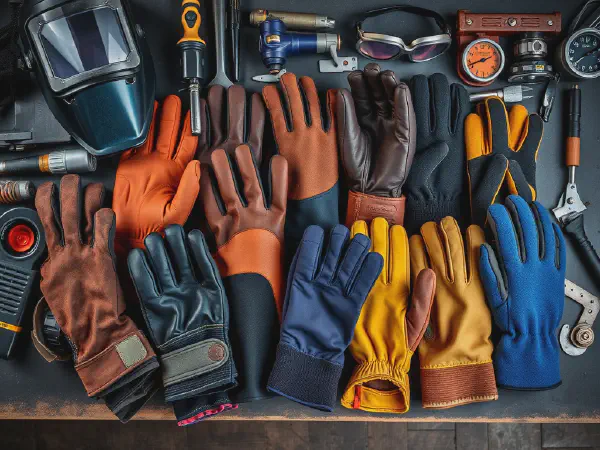Discover the Top Rated Welding Gloves for Comfort & Safety

Top Rated Welding Gloves for Comfort and Safety
When it comes to welding, safety and comfort are paramount, which is why investing in top rated welding gloves for comfort and safety is essential. These gloves not only protect your hands from heat and sparks but also ensure that you can work efficiently without compromising your mobility.
Top rated welding gloves for comfort and safety can greatly enhance your welding experience. With the right pair of gloves, you can find the perfect balance between protection from hazards and the dexterity needed for intricate tasks. Selecting gloves that are rated for comfort and safety by industry standards can make all the difference in your performance and protection.
Whether you are a professional welder or a DIY enthusiast, finding the top rated welding gloves for comfort and safety requires careful consideration of materials, design, and safety features. In this article, we will take a closer look at what makes welding gloves stand out in terms of comfort and safety, providing you with insights to make an informed decision.
From those working in heavy industrial settings to hobbyists in small workshops, everyone needs reliable welding gloves. It's worth noting that the best gloves ensure that your hands remain protected without sacrificing comfort, allowing for better technique and enhanced control during welding operations.
In summary, the right welding gloves can provide safety, comfort, and efficiency. Choosing among the top rated welding gloves for comfort and safety involves looking into various factors including material quality, comfort features, safety standards, leading brands, and maintenance tips to ensure longevity of your gloves.
Material Quality in Welding Gloves
Welding gloves are primarily made from two types of materials: leather and synthetic materials. Leather gloves are often preferred because of their durability and heat resistance, while synthetic options may offer lighter weight alternatives with varying levels of protection and flexibility.
Leather welding gloves are known for their exceptional heat resistance, making them suitable for high-temperature tasks. On the other hand, synthetic materials, which include Kevlar and other polymers, can provide flexibility and cut resistance but may not always withstand as much heat as leather. Each type has its unique advantages depending on the specific needs of the welder.
Heat resistance ratings, often indicated in degrees Fahrenheit, are crucial in selecting welding gloves. Most top rated gloves will feature a heat resistance rating of at least 400°F, while some specially designed gloves can withstand temperatures beyond 900°F. Understanding these ratings helps ensure that you choose a pair that aligns with the intensity of your welding jobs.
Comfort Features of Welding Gloves
Ergonomic designs in welding gloves are essential for fostering a better grip and allowing ease of motion. Gloves that are tailored to fit the natural shape of the hands reduce fatigue and provide a more comfortable experience during prolonged use.
Padded linings in welding gloves enhance comfort by providing cushioning that absorbs impact and reduces strain on the hands. This feature is particularly important for welders who may be handling heavy equipment or working in physically demanding conditions.
Adjustable wrist closures are another vital comfort feature of welding gloves. Gloves equipped with Velcro or snap fastenings ensure a snug fit, preventing exposure to sparks and heat while also allowing for quick on and off capabilities, catering to the needs of a dynamic work environment.
Safety Standards for Welding Gloves
Understanding EN and ANSI safety ratings is crucial in selecting welding gloves. These ratings indicate the level of protection a glove provides against various hazards, including heat, cut, and puncture resistance. Top rated gloves generally meet high standards of safety to protect welders from thermal and mechanical risks.
Cut resistance is an important consideration as welders frequently handle sharp or jagged materials. Gloves with a higher cut resistance rating (typically rated from A1 to A9 under the ANSI/ISEA 105 standard) are essential for safeguarding the hands effectively during weld prep and during welding itself.
Impact protection features, such as added padding or reinforced areas on the gloves, enhance safety by reducing the risk of injury from accidental bumps or drops. Look for gloves that integrate these features without sacrificing dexterity, as isolation can restrict hand movement needed in welding tasks.
Best Brands for Welding Gloves
Some of the leading brands in the welding glove market include Miller Electric, Lincoln Electric, and Tillman. Each brand offers a unique range of gloves that target different welding applications, ensuring that professionals have access to the best tools for their specific tasks.
A comparative analysis of these brands reveals varying features tailored for specific needs—Miller Electric is known for its innovative designs and comfort, while Lincoln Electric focuses on high durability and protection. Tillman, on the other hand, offers a variety of leather gloves that are highly favored by welded professionals for their craftsmanship.
User reviews and testimonials often highlight the comfort and performance of welding gloves. Many users prefer gloves that offer a balance of heat resistance and dexterity, making it crucial to consider firsthand experiences when choosing the best pair for your needs.
Care and Maintenance of Welding Gloves
Cleaning welding gloves effectively contributes to their longevity. It is recommended to wipe them down after use with a damp cloth and allow them to air dry completely before storing. Avoid immersing gloves in water, as this can damage leather and synthetic materials over time.
To prolong the lifespan of your welding gloves, store them in a cool, dry place and avoid exposure to direct sunlight or extreme heat. Regularly inspect for signs of wear, such as cracks or thinning material, and treat leather gloves with conditioner to prevent them from drying out.
Welding gloves should be replaced when they show significant wear, punctures, or reduced functionality in terms of protection. As a general rule, if gloves no longer fit properly or provide adequate barrier protection, it is time to invest in a new pair.
